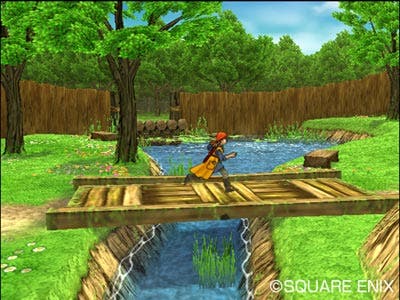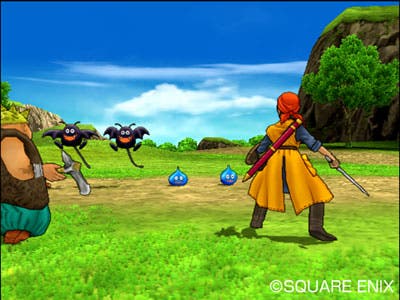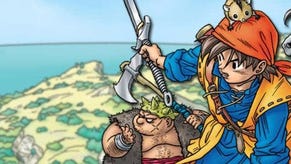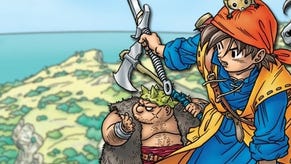Dragon Quest VIII: The Journey of the Cursed King
The most beautiful world in a game.
Over the hill, across the bridge, through the valley and under the shade of an old oak tree, a brilliant white flower sways gently on the virtual breeze.
Once upon a laptop a group of bleary-eyed programmers and artists huddled round, like seers gazing into a liquid-crystal ball, and imagined this future. They deliberated how best to cut the curve of this flower’s stem, heatedly debated what quantities of which colourful hues to inject into its delicate petals. They considered what its blossom would contribute to their world.
A gust of wind cuts the silence with the rasping trebles of leaf-rustle and the near inaudible bass of a cloud’s-breath. The flower’s face dips in reverence, or... was that humble thanks? Either way, as you free your gaze from such microcosmic detail and pan eyes around the surrounding scenery, the flower becomes just one exclamation mark in a spiky sea of blooming punctuation. Ten thousand blades of cel-shaded grass entwine roots with those of virtual trees and polygonal plants; all brethren born from the same pea-green firmament that stretches and rolls for bright, glorious miles off into the watery arms of a blue, blue tide.
Twin hawks slice the warm air above the heads of your band of ragtag travellers as you step out from the first town. Your dragon-eye-ballz, torn from Akira Toriyama’s sketchpad page into peering existence, follow the birds’ chalk-scrawled trail lines. The timpani tumbles, cymbals crash and trumpets trump:
Dragon Quest VIII is begun - the most beautiful world in a game.
Let’s tangent: Imagine, for a moment, that Final Fantasy 7 never happened. The steam-punk grime and poverty chic of Midgar left forgotten as a smudged pencil sketch on a long-discarded drawing pad; the world none the wiser to Sephiroth’s warmth-defying gaze, Aeris’s genre-defying demise and Cloud’s physics-defying swordplay; the future of so many second-rate rip-offs and derivative Blade Runner wannabe RPGs wiped out in one deft flick of the historical plume.

Imagine instead that the most magnificent, beautifully crafted and charming instalment of Japan’s premier orthodox RPG series came to the western world in 1997. Imagine that, although the knights-and-castles setting had been seen in many niche videogames before, it was now made famous and celebrated by this game’s glorious execution. That, instead of innovator Squaresoft, it was refiner Enix that made the videogame world fall in love with the Japanese RPG and set the course of videogame adventuring history.
But that didn’t happen.
This did: the cold castle walls and fairytale romance of the 16 bit SNES RPG pantheon was swept aside in one final fantasy and the fairytale RPG lineage broken off and largely discarded in favour of angst-pouting Japanese teenage protagonists, nu-metal guitars and storylines built from sixth-form metaphysical nonsense.
So Dragon Quest VIII arrives with us as a game from an alternate reality: a multi-million-dollar update for a style of game we left behind a decade ago. It’s not wholly belonging to this world but still, it’s instantly recognisable for, behind the visual form and function skilfully and loving created by Level 5’s master craftsmen, Dragon Quest VIII’s core is as old as videogame time itself.
There is no vast cast of characters to pick up on your journey a la Chrono Cross: just four team members from press-start to denouement. Likewise, no active battle system a la Final Fantasy forces you to negotiate menus at breakneck speed to gain advantage over enemy AI. Rather, lazily tapping the X button with some simple strategising will get you through most fights. There’s none of the FMV-driven narrative show of a Xenosaga. Instead, scenes play out delightfully using the game’s native engine, and only highlight the action sparingly.

Here, there is no Nippon Ichi-esque complex forking character development for you to take your team members off into customised hinterlands: rather, a few simple choices at each level-up point dictate which weapon they excel at quickest. Nor is there any clever item-manipulation mechanic so beloved of titles such as Atelier Iris. Rather you have one alchemy pot into which you can throw two items at a time: if you get lucky five minutes later a new one pops out.
But, although you could describe these binary choices as simple, it’s not the kind of dull-brained, slack-jawed simplicity of an idiot. Rather it’s a refined, unfussy, streamlined, effective, efficient simplicity; a marvel of slight technical balancing and faultlessly chiselled difficulty curves. This is a game which has been play-tested to death, any extraneous gameplay and awkward pacing lopped off until all that is left is polished, sleek, glinting gameplay to slip inside the polished, sleek, glinting gameworld the designers created. They faced the devil in the detail and won calloused-hands-down.
The love and care in the minutiae is staggering and layered twice over: firstly by the original programmers and secondly by the localisation team which brought the game over to the west, and generously added in a host of features not in the original. Firstly, rather than hiring cheap, failing American soap actors to voice the cast of characters populating this world, accents are startlingly European: bright, lively and intelligent - each perfectly matched to the charming dialogue translation. As such, conversations sounds like a mash up of Monty Python and The Princess Bride: fantasy farce driving the cute narrative in the ideal aural vehicle.
Likewise, the soundtrack, stuffed full of midi keyboards and Casio-horn stabs in the original Japanese version has been wholesale rerecorded by a full orchestra for the west and the swimming audio ambience this provides to each step of your adventure is magical.

These additions contribute to a freshness that is in almost direct contrast to what you might expect from the rusty mechanics, random battles and awkwardly placed, infuriating save points. Ironically, the innovation comes from its refinement: no-one has successfully attempted to update the fairytale rescue-the-princess RPG for a long, long time.
So, the most beautiful world in a game? Perhaps. To look at it’s cohesive, well-formed, has some of the best, most inventive enemy designs ever conceived, and the shimmering draw distance constantly beckons you into it’s hazy good-looking promise.
The most beautiful game in the world? Well now, that’s a bold question. True beauty is more than skin deep and so to answer that question requires a whole different set of eyes to perceive and critique. Dragon Quest VIII is full of contradictions and you, eye of the beholder, could see either depending on the way its light catches in your mind: it’s elegant but simple, tired but fresh, grinding but impelling, derivative but engrossing, silly but serious, gentle but bitchy, easy going but tough-as-nails.
But perhaps the biggest juxtaposition of all is that there’s a studied depth in its shallowness that you’ll either fall in love with or ignore completely every time you catch the curve of that little white flower.










